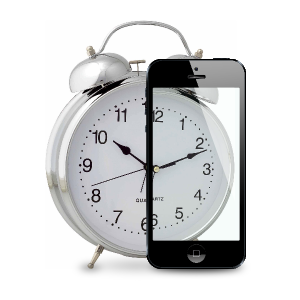
Resources  Visual timers are ideal in assisting with transitions which can be especially difficult for those on the Autism Spectrum. Both transitioning from a preferred activity to an unpreferred one, and from an unpreferred to preferred activity can be very challenging for my son, Michael, who has Autism. We use visual timers to help with both of these types of situations...
Michael loves the free time he gets on the computer every evening after his therapist leaves. I'm quite certain that if permitted, he would stay in front of that screen all night, opting for YouTube over bedtime.
Of course, sleep is a necessity of life so rather than us walking in and abruptly pulling him away from his computer without warning, before his therapist leaves, she sets a visual timer so Michael knows exactly how much time he has left before bed.
The iPad app we use, Picture Prompt Timer, even allows us to give him an extra auditory notice in advance of the final alarm going off. So, ten minutes before bed, Michael hears, "Michael, 10 minutes then bedtime". When that ten minutes elapses, he then hears "Michael, time for bed" and he goes on his way upstairs without a fuss.
Now here's an example of going in the other direction from an unpreferred activity to a preferred one... Michael doesn't especially love his morning routine of getting dressed, making his bed, brushing his teeth, etc. However, he knows that if he does it efficiently and accomplishes everything he needs to do within the allotted time on his visual timer, he can have fifteen minutes of free, uninterrupted time afterwards in the playroom as a reward, which he of course loves and as a result, on most days easily accomplishes.
Visual timers are ideal in assisting with transitions which can be especially difficult for those on the Autism Spectrum. Both transitioning from a preferred activity to an unpreferred one, and from an unpreferred to preferred activity can be very challenging for my son, Michael, who has Autism. We use visual timers to help with both of these types of situations...
Michael loves the free time he gets on the computer every evening after his therapist leaves. I'm quite certain that if permitted, he would stay in front of that screen all night, opting for YouTube over bedtime.
Of course, sleep is a necessity of life so rather than us walking in and abruptly pulling him away from his computer without warning, before his therapist leaves, she sets a visual timer so Michael knows exactly how much time he has left before bed.
The iPad app we use, Picture Prompt Timer, even allows us to give him an extra auditory notice in advance of the final alarm going off. So, ten minutes before bed, Michael hears, "Michael, 10 minutes then bedtime". When that ten minutes elapses, he then hears "Michael, time for bed" and he goes on his way upstairs without a fuss.
Now here's an example of going in the other direction from an unpreferred activity to a preferred one... Michael doesn't especially love his morning routine of getting dressed, making his bed, brushing his teeth, etc. However, he knows that if he does it efficiently and accomplishes everything he needs to do within the allotted time on his visual timer, he can have fifteen minutes of free, uninterrupted time afterwards in the playroom as a reward, which he of course loves and as a result, on most days easily accomplishes.
 Many learners – especially those who have Attention Deficit Disorder (ADD) – often forget what they have set out to accomplish or lose track of time and tend to "get lost" in their thoughts. Again, visual timers can be the ideal solution for staying on task.
A device called the TimeTracker is perfect for staying on track during a showering routine for example. During the green light, you should be soaping your body; during the orange, shampooing your hair, etc.
Many learners – especially those who have Attention Deficit Disorder (ADD) – often forget what they have set out to accomplish or lose track of time and tend to "get lost" in their thoughts. Again, visual timers can be the ideal solution for staying on task.
A device called the TimeTracker is perfect for staying on track during a showering routine for example. During the green light, you should be soaping your body; during the orange, shampooing your hair, etc.
 Activity Schedules are an ideal way to promote independence among special learners. Under the guidance of an activity schedule, learners independently transition from one activity to another so the use of a timer is a must. Spend some time researching activity schedules and discover the endless number of ways that you can enable your child or student to become more independent! To get your started on using Activity Schedules, download this free PowerPoint presentation.
Activity Schedules are an ideal way to promote independence among special learners. Under the guidance of an activity schedule, learners independently transition from one activity to another so the use of a timer is a must. Spend some time researching activity schedules and discover the endless number of ways that you can enable your child or student to become more independent! To get your started on using Activity Schedules, download this free PowerPoint presentation.
There are many visual timers from which to choose. Some are actual devices while others are Apps. Check out this amazing summary by Friendship Circle's Tzvi Schectman. This comprehensive review will be invaluable in helping you find a timer solution that best meets the needs of you and your special learner!
The Benefits Of Using A Visual Timer For Children With Special Needs
Visual timers can play a vital role in the lives of many individuals who have special needs, making participation in important events and necessary activities more tolerable and manageable for all involved.
In this post I cover five situations where a visual timer will be very very helpful.1. Transitioning
 Visual timers are ideal in assisting with transitions which can be especially difficult for those on the Autism Spectrum. Both transitioning from a preferred activity to an unpreferred one, and from an unpreferred to preferred activity can be very challenging for my son, Michael, who has Autism. We use visual timers to help with both of these types of situations...
Michael loves the free time he gets on the computer every evening after his therapist leaves. I'm quite certain that if permitted, he would stay in front of that screen all night, opting for YouTube over bedtime.
Of course, sleep is a necessity of life so rather than us walking in and abruptly pulling him away from his computer without warning, before his therapist leaves, she sets a visual timer so Michael knows exactly how much time he has left before bed.
The iPad app we use, Picture Prompt Timer, even allows us to give him an extra auditory notice in advance of the final alarm going off. So, ten minutes before bed, Michael hears, "Michael, 10 minutes then bedtime". When that ten minutes elapses, he then hears "Michael, time for bed" and he goes on his way upstairs without a fuss.
Now here's an example of going in the other direction from an unpreferred activity to a preferred one... Michael doesn't especially love his morning routine of getting dressed, making his bed, brushing his teeth, etc. However, he knows that if he does it efficiently and accomplishes everything he needs to do within the allotted time on his visual timer, he can have fifteen minutes of free, uninterrupted time afterwards in the playroom as a reward, which he of course loves and as a result, on most days easily accomplishes.
Visual timers are ideal in assisting with transitions which can be especially difficult for those on the Autism Spectrum. Both transitioning from a preferred activity to an unpreferred one, and from an unpreferred to preferred activity can be very challenging for my son, Michael, who has Autism. We use visual timers to help with both of these types of situations...
Michael loves the free time he gets on the computer every evening after his therapist leaves. I'm quite certain that if permitted, he would stay in front of that screen all night, opting for YouTube over bedtime.
Of course, sleep is a necessity of life so rather than us walking in and abruptly pulling him away from his computer without warning, before his therapist leaves, she sets a visual timer so Michael knows exactly how much time he has left before bed.
The iPad app we use, Picture Prompt Timer, even allows us to give him an extra auditory notice in advance of the final alarm going off. So, ten minutes before bed, Michael hears, "Michael, 10 minutes then bedtime". When that ten minutes elapses, he then hears "Michael, time for bed" and he goes on his way upstairs without a fuss.
Now here's an example of going in the other direction from an unpreferred activity to a preferred one... Michael doesn't especially love his morning routine of getting dressed, making his bed, brushing his teeth, etc. However, he knows that if he does it efficiently and accomplishes everything he needs to do within the allotted time on his visual timer, he can have fifteen minutes of free, uninterrupted time afterwards in the playroom as a reward, which he of course loves and as a result, on most days easily accomplishes.
2. Staying On-Task
 Many learners – especially those who have Attention Deficit Disorder (ADD) – often forget what they have set out to accomplish or lose track of time and tend to "get lost" in their thoughts. Again, visual timers can be the ideal solution for staying on task.
A device called the TimeTracker is perfect for staying on track during a showering routine for example. During the green light, you should be soaping your body; during the orange, shampooing your hair, etc.
Many learners – especially those who have Attention Deficit Disorder (ADD) – often forget what they have set out to accomplish or lose track of time and tend to "get lost" in their thoughts. Again, visual timers can be the ideal solution for staying on task.
A device called the TimeTracker is perfect for staying on track during a showering routine for example. During the green light, you should be soaping your body; during the orange, shampooing your hair, etc.
3. Tolerating Unpreferred Activities
Compliance and tolerating necessary but not preferred activities can be especially challenging for those with cognitive challenges who may not be able to appreciate why they have to engage in an activity or how long that activity will last. A visual timer can lay out the expectations for a learner in way that is he or she can understand. A visual timer enabled Michael to remain in the synagogue sanctuary for his brother's Bar Mitzvah and be part of this important family event. Visual timers can be used for everyday activities like brushing teeth, getting a haircut, walking on the treadmill and an endless list of other important daily routines, life skills and tasks.4. Time-Outs
While positive teaching approaches should always be favored over those that focus on punishment, some specific situations may warrant a punishment like a time-out on occasion. What better way to show a child how long he has to remain in his room or in his time-out chair, or refrain from playing with his favorite toy, than with a visual timer!5. Promoting Independence
 Activity Schedules are an ideal way to promote independence among special learners. Under the guidance of an activity schedule, learners independently transition from one activity to another so the use of a timer is a must. Spend some time researching activity schedules and discover the endless number of ways that you can enable your child or student to become more independent! To get your started on using Activity Schedules, download this free PowerPoint presentation.
Activity Schedules are an ideal way to promote independence among special learners. Under the guidance of an activity schedule, learners independently transition from one activity to another so the use of a timer is a must. Spend some time researching activity schedules and discover the endless number of ways that you can enable your child or student to become more independent! To get your started on using Activity Schedules, download this free PowerPoint presentation.


 Which Visual Timer Is Right For You?
Which Visual Timer Is Right For You?
